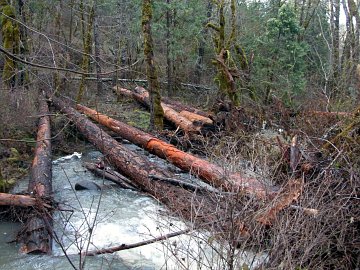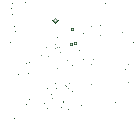~~* The Singing Falls Stream Restoration Project *~~
 ϕ
ϕ
~~*Coho Salmon Habitat*~~
~~*Salmon Habitat: It's All Downhill*~~
The news that water flows downhill, and that fish depend on water, won't come as a shock to anyone.
Yet these statements add up to an often-ignored fact about the habitat needs of salmon (and everything else that depends on the river). Salmon don't just live in water--they live in watersheds. From the crest of the surrounding hills to the estuary at the mouth, a river's watershed is the entire basin from which it gathers its waters. As water percolates through the soil to the stream, down the stream to the river, and eventually out to sea, its quality and quantity is affected by everything it touches. Salmon are affected by anything that happens is the watershed, even though it may seemingly take place far from the river.

Coho Salmon Spawning Habitat
Salmon are affected by the water's temperature and nutrient content, by the amount of sediment and oxygen it carries, by the rate of its flow, and by other factors. All the natural systems in the watershed--forests, meadows, wetlands, rock outcroppings--contribute to the composition of the water.
The watershed determines the amount and force of the water in the river, and the material carried down by its flow from higher elevations. These factors shape the river bottom, which is another important aspect of salmon habitat. Here, behind a large log, the force of the stream may have dug a deep pool, where young salmon shelter in the summer and returning adults rest on their way to the spawning grounds. There, quiet eddies may have dropped their loads of silt, creating mud which supports a marsh. In another place, the river has deposited beds of gravel, which salmon need for spawning. Some species prefer to lay their eggs in pea-sized gravel, while other can use rocks as large as cantaloupes. The particular types of habitat provided by the river depend on the larger influence of the watershed.
Salmon evolved to cope with a sequence of habitats found in natural watersheds. In a typical river system, tributary streams in the upper reaches are heavily shaded by forests, which drop large quantities of leaf litter and other organic material into the water. Fallen trees in the stream trap spawning gravel on the upstream side, and create plunge pools below where young fish shelter and feed. Many of the aquatic insects available as prey in these areas belong to a group know as “shredders”, which devour large bits of plant material floating in the water.
In the middle reaches of the river, the tree canopy opens up and more sunlight falls on the water, prompting algae growth. Here the prey species likely belong to groups know as “scrapers,” which harvest algae from the rocks, and “collectors,” such as net-spinning caddies fly larvae, which strain finer bits of organic material from the water.
At its lower end, the river may wander in many channels across its floodplain, providing a wealth of fish habitats in its wetlands, sloughs and oxbows. In these marshes and estuaries, ocean-bound salmon gorge on clouds of small crustaceans such as copepods and amphipods.
All human activity in the watershed affects salmon habitat. Timber-cutting, for instance, may remove shade and large streamside logs that once fell periodically into the stream. Road construction and agriculture often cause erosion, which in turn fills the water with sediment that can clog spawning gravel. Culverts can block fish passage and alter water flow. Removing creek meanders or beaver dams and filling wetlands eliminates feeding areas and the slow-water areas so important for sheltering young coho and other salmon from the raging winter currents. Dams can slow the force of the river's flow preventing it from cleansing sediment from its bed and moving gravel downstream.
Because human beings live in watersheds, we are part of the salmon's habitat. In many areas, small landowners, timber companies, fishermen, environmentalists, farmers, tribal members, agency representatives, and others are working together to restore watersheds and improve salmon habitat. Often called watershed, these coalitions are finding ways to put aside differences and pool resources to help the salmon. These groups work together to assess the health of their watershed, identify areas where restoration efforts can best help the salmon, and seek out willing landowners to implement habitat restoration projects.
Projects undertaken by watershed groups have included stream surveys, tree planting (to provide shade along stream banks), road and bank stabilization (to prevent erosion), culvert repair (to facilitate fish passage--for both young and adult fish), placing logs in streams (to create shelter and deep pools), side-channel construction (to provide slow water areas for winter shelter), and cattle watering and fencing (to keep cows and sheep out of streams). Participants have included loggers, fishermen, agency personnel, civic groups, environmentalists, and youth groups ...entire communities, taking responsibility for their watersheds.
To learn more about watershed groups in your area, or for more information on how you can assist salmon recovery efforts in the Pacific Northwest, please write the Pacific States Marine Fisheries Commission, 45 SE 82nd Drive, Suite 100, Gladstone, OR 97027-2522.
stream index
top






